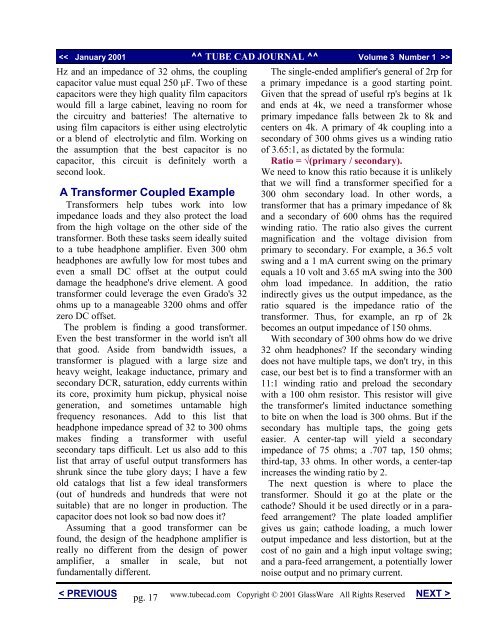Inverted Shunt Regulator - Tube CAD Journal
Inverted Shunt Regulator - Tube CAD Journal
Inverted Shunt Regulator - Tube CAD Journal
Create successful ePaper yourself
Turn your PDF publications into a flip-book with our unique Google optimized e-Paper software.
Hz and an impedance of 32 ohms, the coupling<br />
capacitor value must equal 250 µF. Two of these<br />
capacitors were they high quality film capacitors<br />
would fill a large cabinet, leaving no room for<br />
the circuitry and batteries! The alternative to<br />
using film capacitors is either using electrolytic<br />
or a blend of electrolytic and film. Working on<br />
the assumption that the best capacitor is no<br />
capacitor, this circuit is definitely worth a<br />
second look.<br />
A Transformer Coupled Example<br />
Transformers help tubes work into low<br />
impedance loads and they also protect the load<br />
from the high voltage on the other side of the<br />
transformer. Both these tasks seem ideally suited<br />
to a tube headphone amplifier. Even 300 ohm<br />
headphones are awfully low for most tubes and<br />
even a small DC offset at the output could<br />
damage the headphone's drive element. A good<br />
transformer could leverage the even Grado's 32<br />
ohms up to a manageable 3200 ohms and offer<br />
zero DC offset.<br />
The problem is finding a good transformer.<br />
Even the best transformer in the world isn't all<br />
that good. Aside from bandwidth issues, a<br />
transformer is plagued with a large size and<br />
heavy weight, leakage inductance, primary and<br />
secondary DCR, saturation, eddy currents within<br />
its core, proximity hum pickup, physical noise<br />
generation, and sometimes untamable high<br />
frequency resonances. Add to this list that<br />
headphone impedance spread of 32 to 300 ohms<br />
makes finding a transformer with useful<br />
secondary taps difficult. Let us also add to this<br />
list that array of useful output transformers has<br />
shrunk since the tube glory days; I have a few<br />
old catalogs that list a few ideal transformers<br />
(out of hundreds and hundreds that were not<br />
suitable) that are no longer in production. The<br />
capacitor does not look so bad now does it?<br />
Assuming that a good transformer can be<br />
found, the design of the headphone amplifier is<br />
really no different from the design of power<br />
amplifier, a smaller in scale, but not<br />
fundamentally different.<br />
< PREVIOUS<br />
pg. 17<br />
The single-ended amplifier's general of 2rp for<br />
a primary impedance is a good starting point.<br />
Given that the spread of useful rp's begins at 1k<br />
and ends at 4k, we need a transformer whose<br />
primary impedance falls between 2k to 8k and<br />
centers on 4k. A primary of 4k coupling into a<br />
secondary of 300 ohms gives us a winding ratio<br />
of 3.65:1, as dictated by the formula:<br />
Ratio = √(primary / secondary).<br />
We need to know this ratio because it is unlikely<br />
that we will find a transformer specified for a<br />
300 ohm secondary load. In other words, a<br />
transformer that has a primary impedance of 8k<br />
and a secondary of 600 ohms has the required<br />
winding ratio. The ratio also gives the current<br />
magnification and the voltage division from<br />
primary to secondary. For example, a 36.5 volt<br />
swing and a 1 mA current swing on the primary<br />
equals a 10 volt and 3.65 mA swing into the 300<br />
ohm load impedance. In addition, the ratio<br />
indirectly gives us the output impedance, as the<br />
ratio squared is the impedance ratio of the<br />
transformer. Thus, for example, an rp of 2k<br />
becomes an output impedance of 150 ohms.<br />
With secondary of 300 ohms how do we drive<br />
32 ohm headphones? If the secondary winding<br />
does not have multiple taps, we don't try, in this<br />
case, our best bet is to find a transformer with an<br />
11:1 winding ratio and preload the secondary<br />
with a 100 ohm resistor. This resistor will give<br />
the transformer's limited inductance something<br />
to bite on when the load is 300 ohms. But if the<br />
secondary has multiple taps, the going gets<br />
easier. A center-tap will yield a secondary<br />
impedance of 75 ohms; a .707 tap, 150 ohms;<br />
third-tap, 33 ohms. In other words, a center-tap<br />
increases the winding ratio by 2.<br />
The next question is where to place the<br />
transformer. Should it go at the plate or the<br />
cathode? Should it be used directly or in a parafeed<br />
arrangement? The plate loaded amplifier<br />
gives us gain; cathode loading, a much lower<br />
output impedance and less distortion, but at the<br />
cost of no gain and a high input voltage swing;<br />
and a para-feed arrangement, a potentially lower<br />
noise output and no primary current.<br />
www.tubecad.com Copyright © 2001 GlassWare All Rights Reserved NEXT >

















